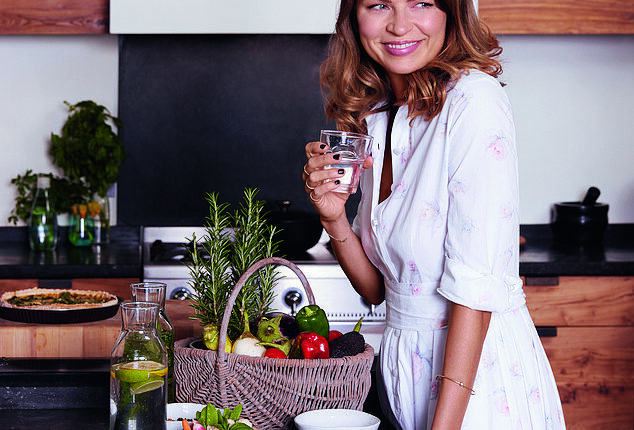As a nutritional therapist, I’ve spent many years helping clients lose weight, boost their metabolism and feel healthier.
While I also treat celebrities and VIPs, most of my clients are everyday women. Many are in midlife, feeling stressed and pulled from all sides as part of the so-called sandwich generation.
They’ve attempted endless diets over the years, yo-yo’d in weight and now feel they’ve hit a wall and nothing is working.
Before I trained in nutrition and studied for a degree in health science, I was a model and know all about fad diets. I tried every one going. Yes, they work initially; but none is sustainable.
Instead, my ethos is centred around creating plans – like this one – that are easy to follow, flexible and don’t leave you feeling deprived or miserable.
You will notice an improvement in how you feel in as little as two days. After a week, you will have more energy, improved sleep and your clothes will feel looser. Best of all, you could lose up to a stone before Christmas.
Here’s everything you need to know…
METABOLISM MYTH
I see so many women in their 40s and 50s, convinced that their metabolism has ground to a halt because of their age and there’s nothing they can do about it. That’s simply not true.
It slows down a little after 40 but it certainly doesn’t drop off a cliff.

Gabriela Peacock (pictured) says: ‘My ethos is centred around creating diet plans that are easy to follow, flexible and don’t leave you feeling deprived or miserable’
When people start gaining weight at this age, it’s nearly always either because unhealthy habits have crept in or because they are less active and have more stress in their life.
Metabolism doesn’t significantly slow down until after around 60. Even then, you can jump-start it by eating the right way.
FANTASTIC FASTING
This plan is based around intermittent fasting, one of the best things you can do to improve your health because it triggers a process in your body called hormesis.
That’s when cells react to a stressor (in this case, a period without food) to prepare for what they believe could be tough times ahead. Your body immediately starts clearing up any damaged cells or stimulating their repair through another process called autophagy.
It’s a very dramatic spring clean that promotes resilience, longevity and weight loss. (And it also means you can slim while you sleep!)
To lose weight effectively we need our bodies to break down fat cells and use them as a source of energy, and that’s what intermittent fasting does brilliantly. It will also balance your blood sugar, which is key for healthy weight loss.
When we eat something sugary, in isolation, such as the biscuits we reach for when we get that afternoon dip, it causes our blood sugar to spike. This then makes us crave more sugary snacks and throws us out of sync for the rest of the day, leading to overeating in the evening.
Don’t feel daunted by the word ‘fasting’. I’m not taking your food away, I’m just going to change how and when you eat it.

‘My plan is designed to super-charge your metabolism to an optimum fat-burning level while balancing your hormones, making you more energetic and promoting quality sleep,’ says Gabriela
I’d also urge anyone thinking of turning to weight-loss jabs to try this first.
The problem with GLP-1 injections is that you lose so much muscle (25 to 40 per cent of weight loss can be down to muscle loss when using these drugs), and the more you lose the slower your metabolism becomes, meaning the minute you stop jabbing you’re likely to regain all the weight you lost in the form of fat, changing the body’s composition – and so begins a vicious cycle.
My plan is designed to super-charge your metabolism to an optimum fat-burning level while balancing your hormones, making you more energetic and promoting quality sleep.
WINDING DOWN YOUR WINDOW
Most of us spend too much time eating. We weren’t designed to be endlessly grazing over a 12- to 14-hour period. I’m going to ask you to eat only during an eight-hour window. So for 16 hours, including the time you’re asleep, you won’t be eating at all.
Pick an eight-hour window that works best with your lifestyle. For most people it’s easier to open their food window around midday or 1pm meaning they will stop eating in the evening.
On this plan you won’t be able to fit in three meals a day. Instead, you’ll have two main meals. But healthy snacking is not only allowed, it’s positively encouraged, so you won’t feel hungry.
If you are someone that needs to eat breakfast, that’s fine. But be aware that if you break your fast at 9am, you won’t be able to eat after 5pm, so make sure that’s a realistic choice.

‘Juices, smoothies and milky coffees will break a fast. However, herbal tea and black coffee are fine, and you can sip these throughout the morning and still be officially fasting’
Juices, smoothies and milky coffees will break a fast. However, black coffee and herbal teas are fine, and you can sip these throughout the morning and still be officially fasting.
Even better, my soup recipe (below) is warming and delicious – but will still keep you in a fasting state.
Your eating window isn’t fixed. You might want to break your fast at 9am Monday to Friday but push it back to lunchtime at the weekend. The key to success is making the plan work for you and your lifestyle.
Once you start eating, leave no longer than four hours between snacks or meals. When you feel peckish, eat. Don’t wait until you’re starving. Just ensure every meal is a balance of protein and carbohydrate to keep blood sugar levels steady.
WHAT’S ON YOUR PLATE?
I’m not going to ask you to measure how much protein you eat. Just make sure it’s included in every meal and snack. Protein will keep hunger at bay and stop blood sugar spikes.
The best sources of protein are chicken, fish, lean red meat, eggs, beans, tofu and pulses.
When it comes to carbohydrates, aim for good-quality complex carbs. No fluffy, white bread or rice. Instead, lean into rye and pumpernickel bread and try brown, black and red rice, and potatoes.
Your main fibre intake will come from vegetables. A good pointer is that if it requires chewing, it’s going to be more fibrous. So, broccoli, beans, cauliflower, green beans over iceberg lettuce, courgette and cucumber, which are mostly water.
I also recommend a good soluble fibre supplement – my favourite is glucomannan, from the root of the konjac plant.
I’ve designed my own, MetaboliseMe – available on GPnutrition.com – or find generic versions in health food stores. Mixed with plenty of water, it can help you feel fuller, preventing any cravings and balancing blood sugar levels.
Make a third of your plate vegetables, a third protein and the remainder carbohydrates, and aim for variety to get the most nutrients.
BRING ON THE BREAKFAST

‘For breakfast, eggs will always fill you up, so try an omelette with ham, cheese or vegetables. If you’re a porridge person, throw in some crushed nuts and seeds to up the protein’
If you choose to eat breakfast, avoid sugary carbs that will cause blood sugar spikes. Try some pumpernickel or rye bread, and, instead of jam, slather it in a nut butter, smashed avocado or smoked salmon.
Good-quality bread may be more expensive but because it is so dense it’s virtually impossible to over-consume, unlike processed white loaves.
Alternatively, eggs will always fill you up – try an omelette with ham, cheese or vegetables. If you’re a porridge person, throw in some crushed nuts and seeds to up the protein.
FLIP YOUR SANDWICH!
If a lunchtime sandwich is your food of choice, instead of having two huge chunks of white bread with a paltry slice of cheese, reverse things.
Choose a quality bread and fill it with a huge wedge of protein such as tinned tuna or salmon, padded out with egg or salad and vegetables. The protein needs to be the biggest component of the sandwich. Soup is also a fantastic lunch option.
SATISFYING SNACKS

‘Nuts and seeds make ideal snacks, as do hard-boiled eggs. Half a dozen Brazil nuts or seven to ten almonds are a great source of healthy fat and protein and will take the edge off hunger’
I think snacks get a bad rap. Used in the right way, you won’t over-eat when you have your main meals.
Nuts and seeds make ideal snacks, as do hard-boiled eggs. Seven to ten almonds or half a dozen Brazil nuts are a great source of healthy fat and protein and will take the edge off hunger.
Protein bars are good, but go for the ones with the highest protein content and don’t confuse them with high-sugar ‘energy’ bars.
A small yogurt, a piece of cheese, some hummus or guacamole on a couple of oatcakes – all delicious, healthy and filling. If you like to snack on fruit, have it with protein, so dip a green apple in a little nut butter to prevent that blood sugar spike.
DOWNSIZE DINNER
Ideally, dinner should be your lightest meal. If you go to bed on a full stomach, unable to burn the calories you’ve just consumed, they invariably end up settling around your midriff area.
Equally, you don’t want to be hungry when you go to bed as your body will start releasing the stress hormone cortisol, resulting in poor-quality sleep.
Instead, aim to eat something light – rye toast with sliced turkey or chicken and a big dollop of hummus is my favourite. A piece of fish with lots of vegetables is a good choice. Try to finish eating around two hours before bed.
I recommend stay-at-home mums or grans doing childcare eat their evening meal with the children at 4pm or 5pm, then a snack a few hours later if you need to.
IT’S OK TO EAT OUT… BUT SNACK FIRST
I know there will be times when you’ll be eating out or just cannot face preparing food and want a takeaway. No problem!
But before going to a restaurant, have a snack – oatcakes and nut butter; a piece of cheese and olives. That way you won’t be starving when you arrive.
Have your takeaway too but if, for example, it’s curry, consider having brown rice instead of white, or even no rice at all. Go for a fish dish or make a vegetable one your main rather than a side.
BOOZE ISN’T BANNED, BUT CAREFUL WITH COFFEE
On this plan, aim for 1.5 to 2 litres of non-caffeinated drinks. Stay hydrated with water and herbal teas. Be careful with coffee. Caffeine and a splash of milk is fine but avoid milk-heavy drinks, such as lattes, which will throw your blood sugar out of whack.
As for alcohol, to get the best results drink as little as possible.
If you plan to drink once the Christmas party season starts, now is a good time to have a break. Can’t bear not having a glass of wine? Drink no more than two to three days a week and always have some protein with your drink.
DIP INTO DESSERTS… WITH LUNCH!

‘If you end up having dessert as part of an evening meal in a restaurant, go for light choices rather than anything rich. A scoop or two of sorbet is ideal’
Enjoy some treats but if you are a dessert person, try to have it with lunch, not dinner, and just a few times a week.
Nuts dipped in dark chocolate are delicious, and I love dark chocolate-covered rice cakes too.
If you do end up having dessert as part of an evening meal in a restaurant, go for light choices rather than anything rich. A scoop or two of sorbet is ideal.
Top tips
Herbal tea is filling, warming and comforting.
Two or three times a week, prep some crudites – such as carrot and cucumber batons – and store them in your fridge. When you need a quick snack, they’re there.
Blitz soft fruit in a blender, add a dollop of yogurt, tip into an ice lolly mould and freeze for a delicious, sweet, refreshing snack.
Fallen off the wagon? Just get back on plan the next day.
MY TWO SLIMMING SECRETS
Edamame & broccoli soup
Packed with vitamin K, folate, fibre and protein. The high antioxidant levels and fibre content will help control blood sugar levels and keep you feeling full all day – and your body won’t treat it as a fast-breaker.

Serves 2
½ tbsp coconut oil
2 spring onions, finely chopped
2 garlic cloves, grated
150g (5½oz) frozen shelled edamame (soya) beans
½ head of broccoli (approx. 200g/7oz), cut into florets and stalk trimmed and chopped
150g (5½oz) dark leafy cabbage, shredded
500ml (18fl oz) vegetable stock (shop-bought or home-made)
Juice of ½ lime
Sea salt and freshly ground pepper
1 tbsp mixed seeds, to serve
Method
1. Heat the oil in a pan over a medium heat. Add spring onions and fry for a couple of minutes before adding the garlic for another minute.
2. Next add the edamame, broccoli, cabbage and stock – bring to the boil then reduce the heat. Simmer for about 20 minutes.
3. Remove from the heat and add the lime juice. Then use a blender to blitz until smooth. Season and serve with a sprinkling of crunchy seeds.
Crunchy roasted chickpeas
An amazing, healthy snack, roasted chickpeas are high in soluble fibre, which will keep your digestion happy and also help reduce any feelings of hunger.
They’re delicious in salads as an alternative to croutons, and the flavour options are endless, from lime and cracked pepper to dark chocolate.

Serves 2
400g (14oz) can of chickpeas, drained and rinsed (240g/8½oz drained weight)
½ tbsp olive oil
1 tbsp apple cider vinegar
Sea salt and freshly ground pepper
Method
1. Preheat the oven to 200c (400f), gas mark 6. Pat the chickpeas dry with a tea towel – this will help them crisp up properly.
2. Add the oil, season and mix well to ensure the chickpeas are coated. Tip on to a baking tray. Roast for 20 minutes, then shake and cook for a further ten minutes.
3. Remove from oven, add the vinegar and toss, then return to the oven for one minute; they should emerge golden and crunchy.
4. Leave to cool and store in an airtight container.
- Recipes taken from 2 Weeks To A Younger You, by Gabriela Peacock (Octopus Publishing Group).









